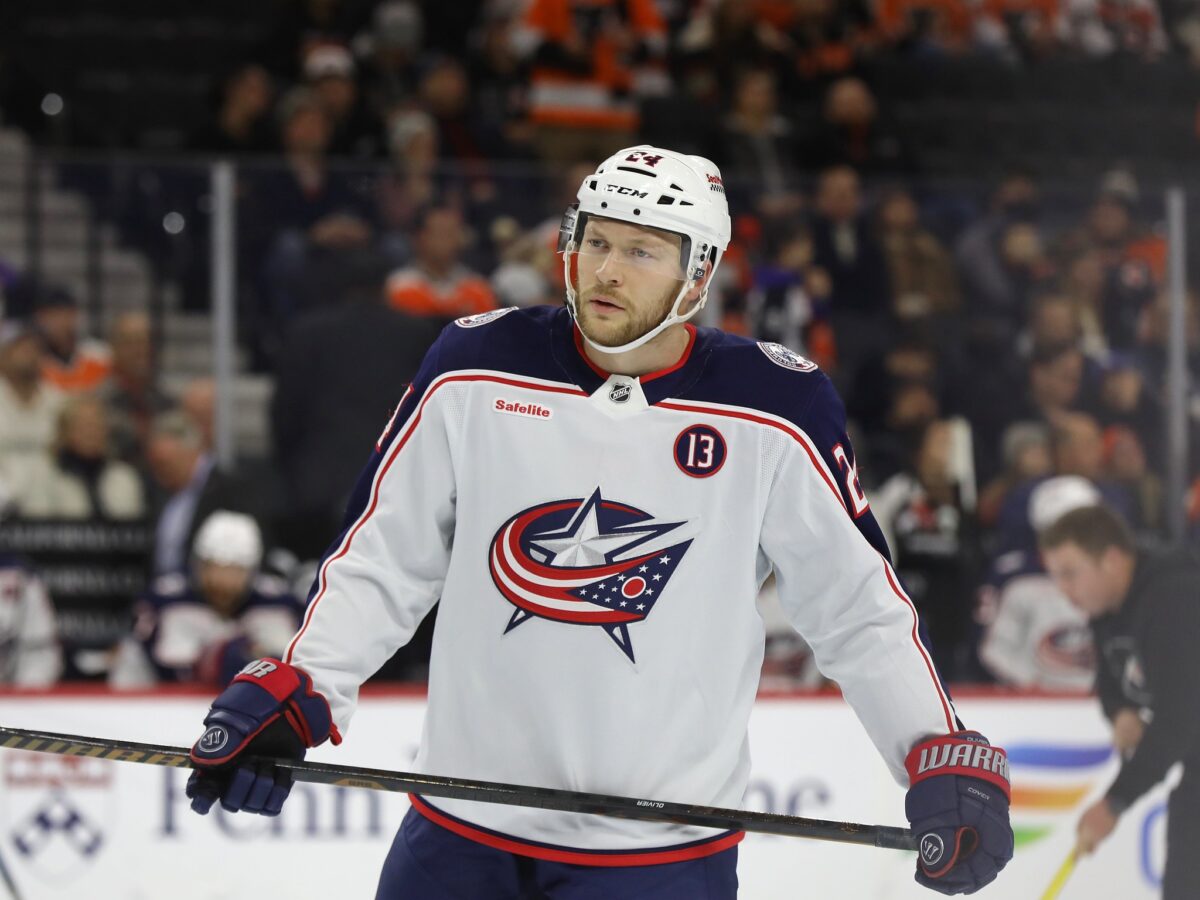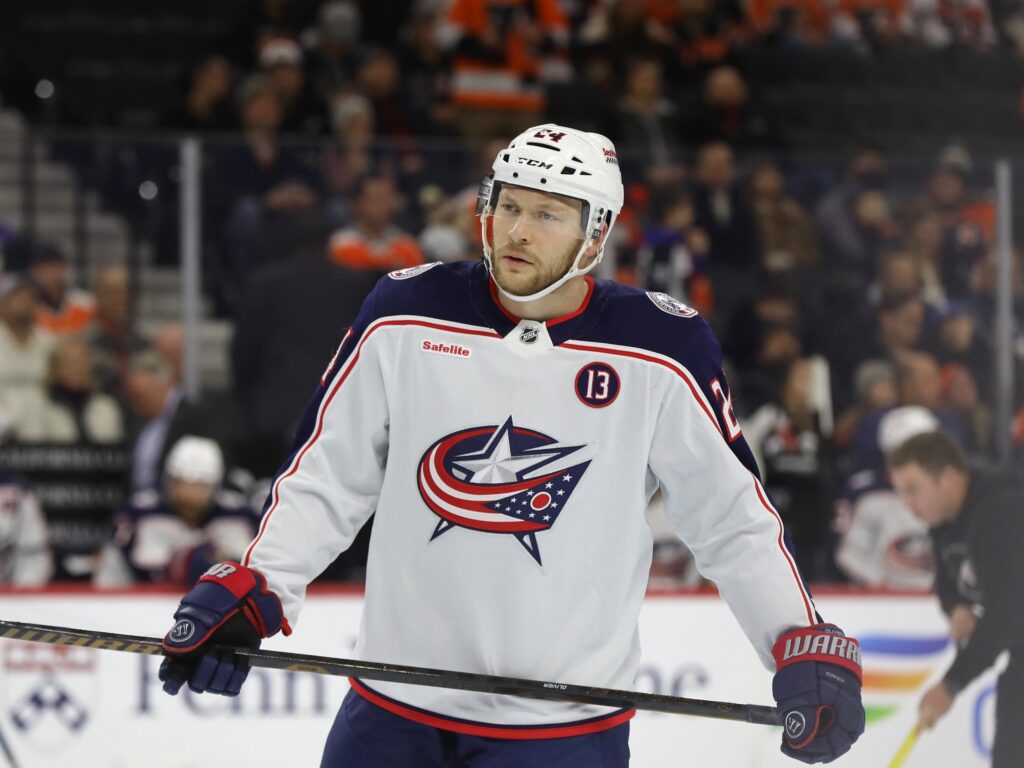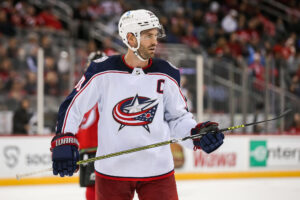Lost a little bit in the shuffle of the hectic NHL trade deadline was the contract extension for Columbus Blue Jackets’ enforcer Mathieu Olivier. He is one of the few NHLers that have been able to take the enforcer role and keep it relevant in the league’s new skill-based era. He’s not simply there for the big hit or to drop the mitts, but he can also be effective as a good skater and occasionally pitch in the big goal.
The Blue Jackets acquired Olivier in the summer of 2022 as they thought they were a little too soft and needed to add some muscle. You’ll recall that was the same offseason that they signed gargantuan defenseman Erik Gudbranson for that same purpose. The two players have come in and performed as advertised, adding some grit to support their very skilled group of young players.
Now, Olivier has become a favorite of the Blue Jackets’ organization and fanbase. He’s been rewarded with a six-year, $18 million contract extension – $3 million average annual value (AAV) – and is tied for the player with the most term left on their contract in the organization with defenseman Damon Severson, the two locked up until 2030-31. It’s not often you see a depth player get that much term. Let’s look into how warranted this is and how it projects with the planned increases in the league’s salary cap.
Olivier’s NHL Edge Metrics
In the days of old, the “enforcer” was something that every team had. One player that would play anywhere between three and eight minutes per night, only leaned on when their coach needed a big hit or a fight to inject a spark to jolt their team’s energy level. They would rack up about as many penalty minutes as time on ice and many would end their careers that spanned hundreds of games with less than a handful of appearances on the scoresheet.

Then came the 2004-05 lockout and the crackdown on enforcement of rules. Referees started policing the game a little bit more, and so the vigilante justice often imposed by enforcers became less needed. Since then, we’ve seen a gradual uptick in the importance of skill-based hockey and a steep decline of physicality-based hockey. While the floodgates have opened and smaller skilled players have more of a home in the NHL than ever before, larger players with less speed that mostly were there to protect the team’s stars have been phased out.
Fortunately for the Blue Jackets, Olivier has enough skill to bridge the gap between the enforcer of old and the skill players of today. He’s one of a very rare breed, which certainly elevates his importance to the Blue Jackets’ organization and explains why they’ve signed him for so long. Guys like him do not come around often.
And the advanced stats back him up, suggesting he’s got what it takes to keep up with the skill side of things. Aside from his career-high 12 goals this season – for comparison, long-time NHL enforcer Colton Orr had 12 goals in 477 career games played – Olivier’s NHL Edge metrics often put him above average.
Related: Blue Jackets’ Olivier’s Extension Shows Belief in Where Team is Going
Most of his skating stats put him in the 50th percentile or above in the league. His 22.73 miles per hour (MPH) top speed puts him in the 73rd percentile. His gross shooting numbers aren’t the best, at least from a shot speed perspective, but most of his shots have come when he’s in tight to the net. He certainly is capable of launching one though, his top shot speed of 88.19 MPH is in the 70th percentile among forwards. However, you’re just way less likely to get one off that hard when you’re three feet from the net.
If he’s able to maintain his strong skating and can make a home for himself in front of the opposing team’s net, people will be happy with this contract. I’m not expecting him to go full-on Zach Hyman and score 56 goals a season from that spot, but he will certainly continue to make himself an effective part of the team.
Olivier’s Contract Projected
When the Chicago Blackhawks signed their fourth line center, Marcus Kruger, to a three-year deal worth just over $3 million AAV in 2016, that was a clear example of overpaying for a depth piece. Despite being two very different styles of players, Olivier’s contract clocks in at around the same AAV. His doesn’t have quite the same “overpaid” connotations, although it may seem to.
In 2016-17, the salary cap was $73.1 million, which puts the Kruger contract at about $3.7 million AAV in today’s dollars – which is a lot of money to pay a fourth-line player. We can do the same level of projecting through percentage of the cap on the Olivier contract in reverse to see how this will be equivalent to today’s cap situation based on the substantial rises coming over the next three seasons.
| Season | Salary cap | Olivier percentage of cap | Value of $3 million AAV in today’s cap dollars |
| 2025-26 | $95.5 million | 3.14% | $2.764 million |
| 2026-27 | $104 million | 2.88% | $2.538 million |
| 2027-28 | $113.5 million | 2.64% | $2.326 million |
Three seasons from now, Olivier will be in year three of this extension making $3 million. Projecting backward, in that season, his cap hit will be equivalent to just over $2.3 million in today’s economy. It’s still double what he was making before the extension, but with how important he’s become to the locker room, along with his uptick in on-ice performance, that’s not an unruly amount to pay him. And that’s only in year three of six; as the cap continues to rise, it will only get more and more palatable.
Time will be the true judge of the positive or negative impact of this long-term contract extension on the Blue Jackets’ organization. If Olivier continues to impact the team the way he has this season, it should be a success. However, if his body breaks down due to the physical nature of his style of play, it could hamper the team for the foreseeable future.
My projection: his body is built like a tank, he has no major injury history, and he’s got a low number of NHL games under his belt thus far – just over 230 games played. All available information lends itself to the idea that Olivier should be able to sustain what he’s done in the long term. If he does so, he could see the same longevity that fellow enforcer Ryan Reaves has and could also play into his late 30s. If that’s the case, this signing will be a home run for Columbus.








